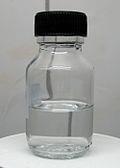Formic acid
| Infobox on Formic acid | |
|---|---|
| Example of Formic acid |  |
| Facts | |
| Origin | - |
| Stowage factor (in m3/t) | - |
| Humidity / moisture | - |
| Ventilation | - |
| Risk factors | See text |
Formic acid
Description
Formic acid (also called methanoic acid) is the simplest carboxylic acid. Its chemical formula is HCOOH or HCO2H. It is an important intermediate in chemical synthesis and occurs naturally, most notably in ant venom. In fact, its name comes from the Latin word for ant, formica, referring to its early isolation by the distillation of ant bodies. Esters, salts, and the anion derived from formic acid are referred to as formates.
Formic acid is a colourless liquid having a highly pungent, penetrating odour at room temperature. It is miscible with water and most polar organic solvents, and is somewhat soluble in hydrocarbons. In hydrocarbons and in the vapour phase, it consists of hydrogen-bonded dimers rather than individual molecules. Owing to its tendency to hydrogen-bond, gaseous formic acid does not obey the ideal gas law. Solid formic acid (two polymorphs) consists of an effectively endless network of hydrogen-bonded formic acid molecules. This relatively complicated compound also forms a low-boiling azeotrope with water (22.4%) and liquid formic acid also tends to supercool.
Application
A major use of formic acid is as a preservative and antibacterial agent in livestock feed. In Europe, it is applied on silage (including fresh hay) to promote the fermentation of lactic acid and to suppress the formation of butyric acid; it also allows fermentation to occur quickly, and at a lower temperature, reducing the loss of nutritional value. Formic acid arrests certain decay processes and causes the feed to retain its nutritive value longer, and so it is widely used to preserve winter feed for cattle. In the poultry industry, it is sometimes added to feed to kill the E. coli bacteria. Use as preservative for silage and (other) animal feed constituted 30% of the global consumption in 2009.
Formic acid is also significantly used in the production of leather, including tanning and in dyeing and finishing of textile because of its acidic nature and also used as a coagulant in the production of rubber.
Furthermore, formic acid is used instead of mineral acids for various cleaning products, such as limescale remover and toilet bowl cleaner. Some formate esters are artificial flavourings or perfumes. Beekeepers use formic acid as a miticide against the tracheal mite (Acarapis woodi) and the Varroa mite. The use of formic acid in fuel cells is also under investigation.
Shipment / Storage
Properties of formic acid
Flash point : 69°C (156°F)
Autoignition
Temperature : 601°C
Explosive limits : 14–34%<br.
LD50 : 700 mg/kg (rat, oral)
Melting point : 8.4°C
Boiling point : 100.8°C
Solubility in water : miscible
Solubility : miscible with ether, acetone, ethyl acetate, glycerol, methanol, ethanol, partially soluble in benzene, toluene, xylenes











